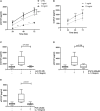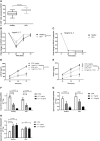IL-7 induces sCD127 release and mCD127 downregulation in human CD8+ T cells by distinct yet overlapping mechanisms, both of which are impaired in HIV infection
- PMID: 32390135
- PMCID: PMC7586945
- DOI: 10.1002/eji.201948453
IL-7 induces sCD127 release and mCD127 downregulation in human CD8+ T cells by distinct yet overlapping mechanisms, both of which are impaired in HIV infection
Abstract
The IL-7 receptor specific α chain, CD127, can be expressed both as a membrane-associated (mCD127) and a soluble form (sCD127), however, the mechanisms involved in their regulation remain to be defined. We first demonstrated in primary human CD8+ T cells that IL-7-induced downregulation of mCD127 expression is dependent on JAK and PI3K signaling, whereas IL-7-induced sCD127 release is also mediated by STAT5. Following stimulation with IL-7, expression of alternatively spliced variants of the CD127 gene, sCD127 mRNA, is reduced, but to a lesser degree than the full-length gene. Evaluation of the role of proteases revealed that MMP-9 was involved in sCD127 release, without affecting the expression of mCD127, suggesting it does not induce direct shedding from the cell surface. Since defects in the IL-7/CD127 pathway occur in various diseases, including HIV, we evaluated CD8+ T cells derived from HAART-treated HIV-infected individuals and found that IL-7-induced (1) downregulation of mCD127, (2) release of sCD127, and (3) expression of the sCD127 mRNA were all impaired. Expression of mCD127 and sCD127 is, therefore, regulated by distinct, but overlapping, mechanisms and their impairment in HIV infection contributes to our understanding of the CD8+ T cell dysfunction that persists despite effective antiretroviral therapy.
Keywords: CD127; CD8+ T cells; HAART; HIV; IL-7.
© 2020 The Authors. European Journal of Immunology published by WILEY-VCH Verlag GmbH & Co. KGaA, Weinheim.
Conflict of interest statement
The authors declare no commercial or financial conflict of interest.
Figures





Similar articles
-
Interleukin-7 regulates CD127 expression and promotes CD8+ T cell activity in patients with primary cutaneous melanoma.BMC Immunol. 2022 Jul 18;23(1):35. doi: 10.1186/s12865-022-00509-0. BMC Immunol. 2022. PMID: 35850640 Free PMC article.
-
IL-7 and the HIV Tat protein act synergistically to down-regulate CD127 expression on CD8 T cells.Int Immunol. 2009 Mar;21(3):203-16. doi: 10.1093/intimm/dxn140. Epub 2009 Jan 15. Int Immunol. 2009. PMID: 19147839
-
IL-7-dependent STAT-5 activation and CD8+ T cell proliferation are impaired in HIV infection.J Leukoc Biol. 2011 Apr;89(4):499-506. doi: 10.1189/jlb.0710430. Epub 2010 Dec 21. J Leukoc Biol. 2011. PMID: 21177484
-
Expression of γ-chain cytokine receptors on CD8+ T cells in HIV infection with a focus on IL-7Rα (CD127).Immunol Cell Biol. 2012 Apr;90(4):379-87. doi: 10.1038/icb.2011.66. Epub 2011 Aug 23. Immunol Cell Biol. 2012. PMID: 21863001 Review.
-
The influence of HIV on CD127 expression and its potential implications for IL-7 therapy.Semin Immunol. 2012 Jun;24(3):231-40. doi: 10.1016/j.smim.2012.02.006. Epub 2012 Mar 14. Semin Immunol. 2012. PMID: 22421574 Review.
Cited by
-
Interleukin-7 regulates CD127 expression and promotes CD8+ T cell activity in patients with primary cutaneous melanoma.BMC Immunol. 2022 Jul 18;23(1):35. doi: 10.1186/s12865-022-00509-0. BMC Immunol. 2022. PMID: 35850640 Free PMC article.
-
The Relationship Between Soluble Interleukin-17 Receptor Levels and CD3-Positive T Cells and Lymphocytes in Patients with Sepsis and Their Predictive Clinical Significance.J Inflamm Res. 2024 Oct 21;17:7543-7550. doi: 10.2147/JIR.S479310. eCollection 2024. J Inflamm Res. 2024. PMID: 39464344 Free PMC article.
-
MAIT cells altered phenotype and cytotoxicity in lupus patients are linked to renal disease severity and outcome.Front Immunol. 2023 Oct 10;14:1205405. doi: 10.3389/fimmu.2023.1205405. eCollection 2023. Front Immunol. 2023. PMID: 37885889 Free PMC article.
-
Recent advances in poor HIV immune reconstitution: what will the future look like?Front Microbiol. 2023 Aug 7;14:1236460. doi: 10.3389/fmicb.2023.1236460. eCollection 2023. Front Microbiol. 2023. PMID: 37608956 Free PMC article. Review.
-
Immunomodulation with IL-7 and IL-15 in HIV-1 infection.J Virus Erad. 2023 Sep 5;9(3):100347. doi: 10.1016/j.jve.2023.100347. eCollection 2023 Sep. J Virus Erad. 2023. PMID: 37767312 Free PMC article.
References
-
- Pallard C., Stegmann A. P., van Kleffens T., Smart F., Venkitaraman A. and Spits H., Distinct roles of the phosphatidylinositol 3‐kinase and STAT5 pathways in IL‐7‐mediated development of human thymocyte precursors. Immunity 1999. 10: 525–535. - PubMed
Publication types
MeSH terms
Substances
Grants and funding
LinkOut - more resources
Full Text Sources
Other Literature Sources
Medical
Research Materials
Miscellaneous

